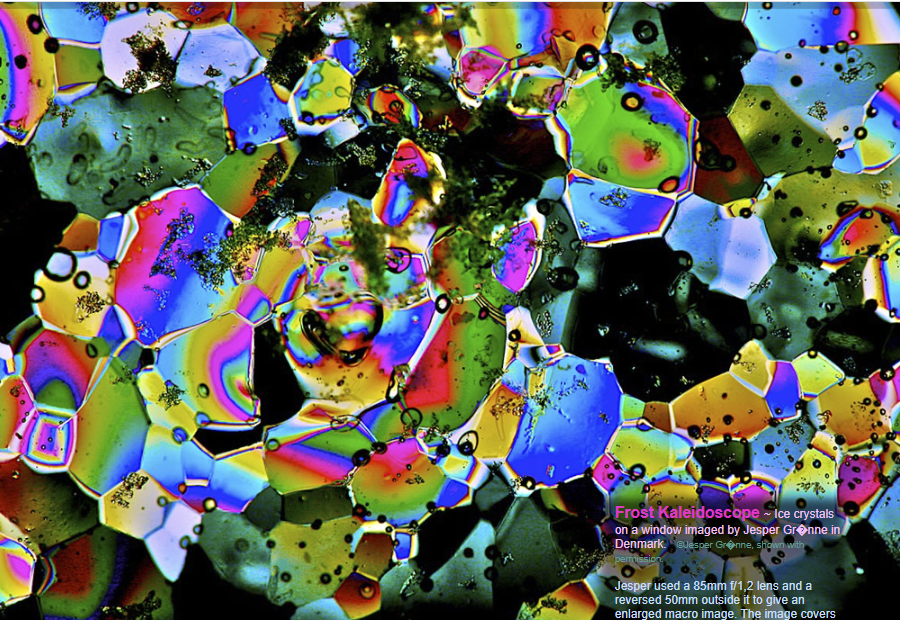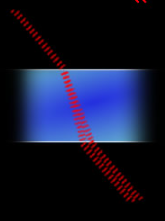Frost kaleidoscope
Frost Kaleidoscope: A Mesmerizing Display of Ice Crystals
When the temperature drops and frost forms on windows, a captivating natural phenomenon occurs. Known as the "Frost Kaleidoscope," this enchanting display is created by ice crystals that grow across the glass from tiny nuclei and surface imperfections. Unlike fern frost, which forms delicate and intricate patterns, the crystals in the Frost Kaleidoscope are small and quickly jostle others before they can grow larger. The close proximity of the growth nuclei or rapid crystal nucleation and growth conditions contribute to the unique appearance of this frost formation.
The Secret Behind the Magical Colors
What makes the Frost Kaleidoscope truly mesmerizing are the vivid colors that can be observed within it. The photographer, Jesper Grönne, discovered that these colors could be revealed by imaging the frost between two crossed polarizing filters. Ice is birefringent or double refracting, meaning that it splits the refracted ray into two components with different polarizations. By placing a polarizing filter on each side of the crystals, the colors resulting from interference between the two birefringent rays become visible.
Birefringence and Thin Film Interference
The colors observed in the Frost Kaleidoscope are not only a result of birefringence but also thin film interference. By rotating the camera polarizer, one can distinguish between these two phenomena. When the camera polarizer is rotated, the birefringent colors change, while those produced by thin films remain constant. This distinction allows for a deeper understanding of the optical processes occurring within the frost crystals.
The Intricate Interference of Waves
To comprehend why these colors appear, we must delve into the physics behind interference. As the refracted rays pass through the ice crystals, they follow different paths, resulting in a phase difference between them. When these waves emerge and interfere, the phase differences become wavelength dependent, giving rise to the vibrant colors we observe in the Frost Kaleidoscope. It is this intricate interference of waves that creates the mesmerizing visual spectacle.
Exploring the Frost Kaleidoscope
The Frost Kaleidoscope presents a fascinating opportunity to explore the wonders of atmospheric optics. By capturing macro images of the ice crystals using specialized lenses, photographers can uncover the intricate details within just a few millimeters of frost formation. The delicate and ever-changing patterns formed by the crystals offer a glimpse into the complexity of nature's artistic creations.
The Influence of Conditions
The appearance of the Frost Kaleidoscope can vary depending on the specific conditions in which it forms. Factors such as temperature, humidity, and the presence of impurities on the glass surface can all impact the growth and arrangement of the ice crystals. These conditions can result in a diverse range of patterns and color combinations, making each Frost Kaleidoscope a unique and captivating sight.
The Beauty of Natural Phenomena
The Frost Kaleidoscope serves as a reminder of the intricate beauty found in even the simplest of natural phenomena. From the delicate structures of ice crystals to the interplay of light and color, this mesmerizing display showcases the awe-inspiring complexity of our world. It invites us to pause and appreciate the wonders that surround us, reminding us of the hidden marvels waiting to be discovered in everyday moments.
Capturing the Frost Kaleidoscope
For those who wish to capture the Frost Kaleidoscope in their own photographs, there are a few techniques to consider. Using a macro lens, like Jesper Grönne did, allows for detailed close-up shots that reveal the intricate patterns within the frost crystals. Additionally, experimenting with different lighting conditions and angles can enhance the visual impact of the kaleidoscopic colors. Patience and observation are key when attempting to capture this fleeting phenomenon, as each frost formation is unique and ever-changing.
Conclusion
The Frost Kaleidoscope is a breathtaking example of the interplay between ice crystals, light, and optics. By understanding the principles of birefringence, thin film interference, and wave interference, we can appreciate the scientific processes that give rise to this captivating display. Whether observed through a window or captured in photographs, the Frost Kaleidoscope invites us to marvel at the beauty of nature's intricate designs. So, the next time frost graces your windowpane, take a moment to witness the magical colors and patterns of this remarkable atmospheric phenomenon.

Frost Kaleidoscope ~ Ice crystals on a window imaged by Jesper Gr�nne in Denmark. ©Jesper Gr�nne, shown with permission.
Jesper used a 85mm f/1,2 lens and a reversed 50mm outside it to give an enlarged macro image. The image covers just a few millimetres.
The crystals grow across the glass from tiny nuclei and surface imperfections. Unlike fern frost these crystals are small and quickly jostle others before they can get larger. The growth nuclei were either very close together or conditions rendered crystal nucleation and growth was rapid.
The secret of the magical colours is that Jesper imaged the frost between two crossed polarising filters.
Ice is birefringent or double refracting (see earlier OPOD ). Placing a polarising filter each side of the crystals reveals the colours that result from interference between the two birefringent rays.
Colours are also produced by thin film interference. Distinguish between them by rotating the camera polariser. birefringent colours then change, those from thin films do not.

Rays through a frost crystal
Ice is birefringent. The refracted ray splits into two components with different polarisation.

The emerging waves have a phase difference because they have different path lengths through the ice. The waves interfere. We see colours because the phase differences are wavelength dependent.
Note: this article has been automatically converted from the old site and may not appear as intended. You can find the original article here.
Reference Atmospheric Optics
If you use any of the definitions, information, or data presented on Atmospheric Optics, please copy the link or reference below to properly credit us as the reference source. Thank you!
-
<a href="https://atoptics.co.uk/blog/frost-kaleidoscope/">Frost kaleidoscope</a>
-
"Frost kaleidoscope". Atmospheric Optics. Accessed on April 16, 2024. https://atoptics.co.uk/blog/frost-kaleidoscope/.
-
"Frost kaleidoscope". Atmospheric Optics, https://atoptics.co.uk/blog/frost-kaleidoscope/. Accessed 16 April, 2024
-
Frost kaleidoscope. Atmospheric Optics. Retrieved from https://atoptics.co.uk/blog/frost-kaleidoscope/.